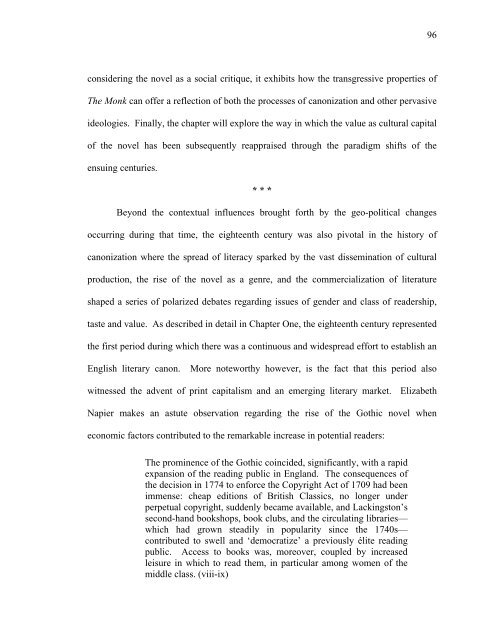Untitled - Sexey's School Moodle
Untitled - Sexey's School Moodle
Untitled - Sexey's School Moodle
Create successful ePaper yourself
Turn your PDF publications into a flip-book with our unique Google optimized e-Paper software.
considering the novel as a social critique, it exhibits how the transgressive properties of<br />
The Monk can offer a reflection of both the processes of canonization and other pervasive<br />
ideologies. Finally, the chapter will explore the way in which the value as cultural capital<br />
of the novel has been subsequently reappraised through the paradigm shifts of the<br />
ensuing centuries.<br />
* * *<br />
Beyond the contextual influences brought forth by the geo-political changes<br />
occurring during that time, the eighteenth century was also pivotal in the history of<br />
canonization where the spread of literacy sparked by the vast dissemination of cultural<br />
production, the rise of the novel as a genre, and the commercialization of literature<br />
shaped a series of polarized debates regarding issues of gender and class of readership,<br />
taste and value. As described in detail in Chapter One, the eighteenth century represented<br />
the first period during which there was a continuous and widespread effort to establish an<br />
English literary canon. More noteworthy however, is the fact that this period also<br />
witnessed the advent of print capitalism and an emerging literary market. Elizabeth<br />
Napier makes an astute observation regarding the rise of the Gothic novel when<br />
economic factors contributed to the remarkable increase in potential readers:<br />
The prominence of the Gothic coincided, significantly, with a rapid<br />
expansion of the reading public in England. The consequences of<br />
the decision in 1774 to enforce the Copyright Act of 1709 had been<br />
immense: cheap editions of British Classics, no longer under<br />
perpetual copyright, suddenly became available, and Lackingston’s<br />
second-hand bookshops, book clubs, and the circulating libraries—<br />
which had grown steadily in popularity since the 1740s—<br />
contributed to swell and ‘democratize’ a previously élite reading<br />
public. Access to books was, moreover, coupled by increased<br />
leisure in which to read them, in particular among women of the<br />
middle class. (viii-ix)<br />
96



